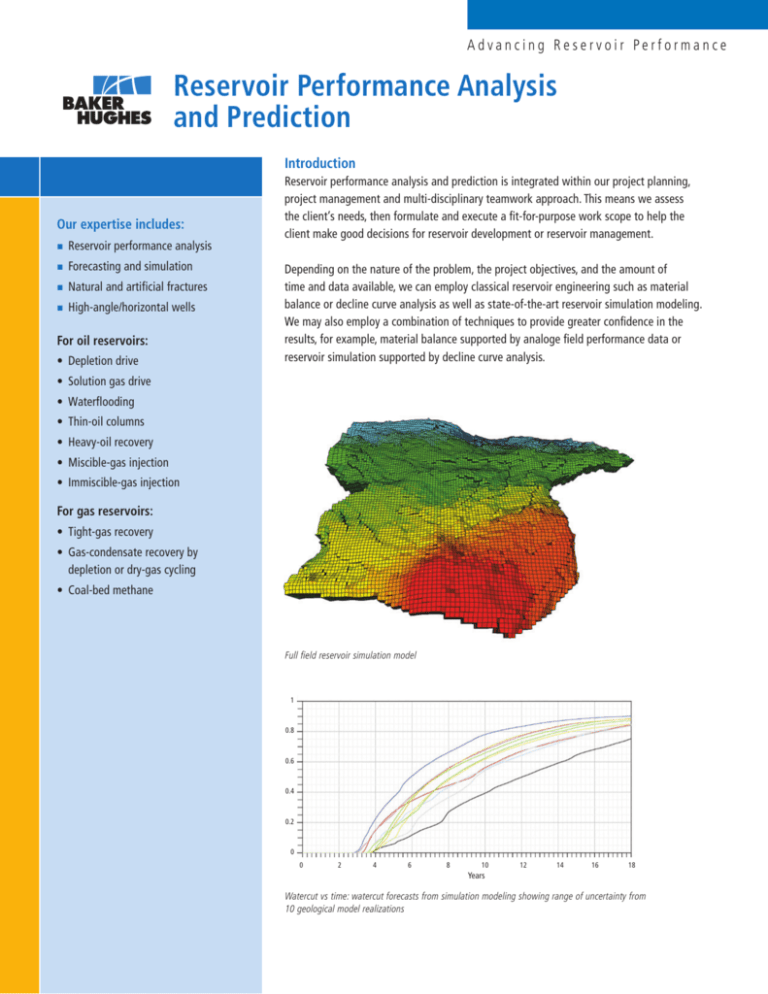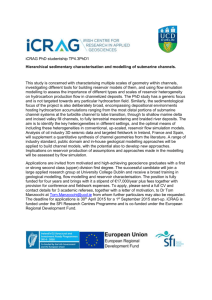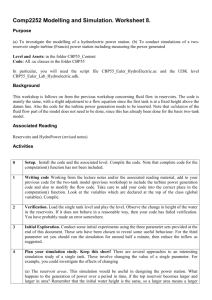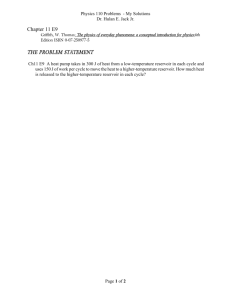
Advancing Reservoir Performance
Reservoir Performance Analysis
and Prediction
Introduction
Our expertise includes:
Reservoir performance analysis
Forecasting and simulation
Natural and artificial fractures
High-angle/horizontal wells
For oil reservoirs:
• Depletion drive
Reservoir performance analysis and prediction is integrated within our project planning,
project management and multi-disciplinary teamwork approach. This means we assess
the client’s needs, then formulate and execute a fit-for-purpose work scope to help the
client make good decisions for reservoir development or reservoir management.
Depending on the nature of the problem, the project objectives, and the amount of
time and data available, we can employ classical reservoir engineering such as material
balance or decline curve analysis as well as state-of-the-art reservoir simulation modeling.
We may also employ a combination of techniques to provide greater confidence in the
results, for example, material balance supported by analoge field performance data or
reservoir simulation supported by decline curve analysis.
• Solution gas drive
• Waterflooding
• Thin-oil columns
• Heavy-oil recovery
• Miscible-gas injection
• Immiscible-gas injection
For gas reservoirs:
• Tight-gas recovery
• Gas-condensate recovery by
depletion or dry-gas cycling
• Coal-bed methane
Full field reservoir simulation model
1
0.8
0.6
0.4
0.2
0
0 2 4 6 8 10 12 14 16 18
Years
Watercut vs time: watercut forecasts from simulation modeling showing range of uncertainty from
10 geological model realizations
Reservoir simulation model showing
water encroachment and gas coning
into a horizontal well
Baker Hughes Reservoir Development
Services (RDS) has extensive experience
with a large number of different petroleum
reservoirs and recovery mechanisms.
We also perform analysis and production
forecasting for fields at all stages of
development, ranging from exploration
through appraisal, early production and
very mature fields.
Decline curve, material balance
and analytical model forecasting
Decline curve forecasting is suitable where
there are well established production
decline trends (e.g. mature fields), and the
objective is to predict production under
the existing operational conditions.
Material balance is a common forecasting
method for depletion drive in oil and
gas reservoirs. It assumes the reservoir is
tank-like which may not be appropriate
for low-permeability or compartmentalized
reservoirs. However, material balance
models can be used where there is
little reservoir data and/or reservoir
uncertainties are large. RDS commonly
employs the commercial MBal/Prosper1
tools for material balance analysis. This
type of model can be readily extended
to integrated production modeling
by including the surface flowline and
production facilities. This is appropriate
for short-term production forecasting
and optimization.
RDS also has expertise in production
analysis and forecasting with analytical
transient flow models available in the
commercial software packages Pansystem2
and Saphir3. This type of model is most
suitable for depletion drive where the well
drainage area remains constant over time.
Reservoir simulation modeling
Reservoir simulation modeling is the
main stay of reservoir performance
analysis and production forecasting
in the petroleum industry. This is the
only forecasting technique which really
accounts for complexities in the reservoir
description such as heterogeneity,
structure, and faulting together with
multi-phase flow, well geometry and
detailed well/production scheduling.
We find that reservoir simulation studies
are most successful where they are
closely integrated with RDS reservoir
description services and particularly when
delivered through RDS core teams.
RDS has considerable experience
conducting simulation studies with
industry-standard commercial simulators
Eclipse4 and VIP5. We perform simulation
studies tailored to the project objectives
and the quantity and quality of available
data. We try to keep the model as simple
as possible and only add complexity
when required to meet the project
requirements. This means we don’t waste
time and money including factors which
do not impact the reservoir management
decisions. For example, in an appraisal
or pre-development situation, it may be
more appropriate to investigate multiple
geological scenarios with a simple model
rather than a complex simulation which
only addresses a single geological model.
Conversely, for mature fields with a large
amount of well data and production
history, a detailed model is more suitable,
e.g. to resolve infill drilling targets.
History matching is a significant issue
for producing fields, especially mature
fields. RDS has substantial experience of
history matching particularly for water
flood developments and gas reservoirs.
Probably the most important issue is to
understand the ranges of uncertainty and
what parameter changes are realistic.
These could be reservoir description
parameters, but there are also errors
associated with measured production
and pressure data. Again, for history
matching, RDS recommend integration
with our reservoir description services
and delivery through a core team to
achieve a technically superior result
while saving time and money.
Software Vendors
1
Petroleum Experts
2
eProduction Solutions/Weatherford
3
Kappa Engineering
4
Geoquest/Schlumberger
5
Landmark/Halliburton
www.bakerhughes.com/rds
© 2010 Baker Hughes Incorporated. All rights reserved. 30522






